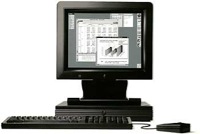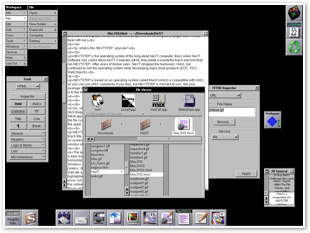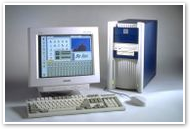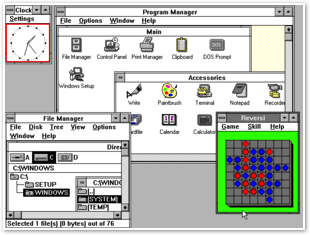




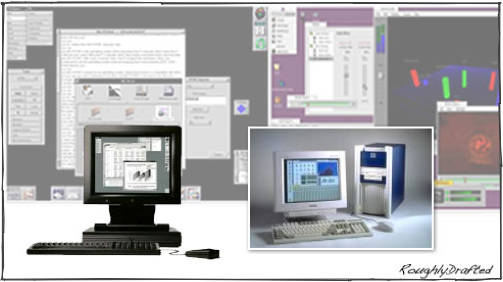
While Apple struggled with different projects replace, retrofit, and renew the Mac platform, it also began to face competition from a new generation of computing platforms, two of which split directly from Apple itself: NeXT and Be. Here's what each offered.

Platform Death Match introduced the difficulty of launching a new platform and the work involved in maintaining one. This series looks at the historical march of computing platforms, to sort out why winners won and why losers lost. While the computing environment is always changing, the same basic rules are in effect today, and will shape the future developments between Mac OS X Leopard and Windows Vista.
Previous articles:

1990-1995: NeXT, Be, and the Mac PC
Apple worked to compete with clean, new platform designs from NeXT and Be, while also struggling to deliver its own future plans.
NeXT Computer
Steve Jobs, after being pushed out of Apple, the company he founded, at the behest of John Sculley, the CEO he hired to run it, had founded NeXT, a new company that spent the late 80's designing the computing platform system of the future.
Using his own fortune from Apple, and later significant funding from billionaire Ross Perot of EDS, Jobs assembled a team of hardware engineers from Apple's Macintosh and Lisa teams, and a software design team lead by Avie Tevanian of Carnegie Mellon University.
 While Apple was entering maintenance mode of the Mac platform, the "last new thing," NeXT represented the "next big thing." The allure of inventing the future allowed NeXT to syphon off top engineering talent. Since so many of NeXT's engineers came from Apple, the two companies largely shared a similar vision for the future.
While Apple was entering maintenance mode of the Mac platform, the "last new thing," NeXT represented the "next big thing." The allure of inventing the future allowed NeXT to syphon off top engineering talent. Since so many of NeXT's engineers came from Apple, the two companies largely shared a similar vision for the future. Both were looking at Motorola's next generation RISC processor, the 88100; both were working with using Unix as an modern operating system foundation; and both had a similar goal of providing a powerful, easy to use, and elegant platform as an entire package solution.
The difference between Apple and NeXT is that Apple had existing customers and developers. That was both an obvious advantage and a potential drawback. As the 1985-1990 segment demonstrated, it was becoming increasingly difficult to introduce entirely new platforms.
However, Apple's installed base of software and hardware also carried a burden of legacy for Apple to support. NeXT could freely introduce new hardware and software technology in ways the increasingly conservative Apple couldn't.
NeXT hoped to leapfrog the Mac just as the Mac had leapfrogged 8-bit computers a generation earlier.
The NeXT Cube
By 1990, NeXT had introduced the NeXT computer as a workstation class machine which used the latest 68030, specialized DSP hardware processing, state of the art operating system technology based on the Mach kernel and incorporating a POSIX compatible BSD subsystem, and a highly advanced object-oriented application development system.
NeXT delivered much of its advances by building its new platform upon existing technologies from workstation class Unix systems, as well as ideas pioneered by Apple, including use of the 68k processor, SCSI, NuBus, and ADB. While NeXT offered a lot of new things, it was in many areas a collection of the existing state of the art in technology.
Standing on the Shoulders of Giants
This enabled NeXT to quickly deliver significant and differentiating new features while wasting less time reinventing basic technologies. For example, by presenting a POSIX compliant userland, NeXT offered software compatibility and familiarity for Unix users.
This also enabled NeXT to deliver lots of operating system technologies for free, without having to implement its own systems for common things such as file permissions and a multiuser environment. Unix had already presented mature solutions to those needs.
Finding a Market
NeXT's new platform was positioned in direct competition with Apple's high end Macs. Legal disputes between Apple and NeXT over the migration of former Apple employees to the new company resulted in an agreement between the two that limited NeXT from competing in the lower end of the market. NeXT's pioneering technologies tended to make it too expensive for the desktop market anyway.
NeXT was still competitive with other Unix workstations however, and compatibility with existing POSIX software allowed NeXT a head start over Apple in that market. Further, NeXT's rapid development frameworks helped accelerate custom NeXT software in certain vertical markets. However, it was still a tough sell to introduce an entirely new platform, particularly in the highly competitive workstation market.
Attempts at Reinvention
NeXT struggled to survive by later getting out of the hardware market, and attempting to establish its NeXTSTEP operating system as an alternative to DOS and Microsoft's emerging Windows on the PC. Sun similarly tried to sell its workstation operating system, Solaris, for PCs.
However, even Microsoft was struggling for acceptance its Windows platform; obviously, both NeXT and Sun faced much more difficulty getting established on the PC than the incumbent producer of DOS, which had already lined up exclusive licensing agreements with all of the PC vendors. The fact that NeXT survived through the 1990-1995 period at all is pretty amazing.
Further attempts by NeXT to sell NeXTSTEP as an operating system, and later efforts to sell its higher level frameworks as both an operating environment on top of other operating systems, and as a web application development system, will be discussed later. First, here's a look at another Mac competitor, which also originated as an offshoot of the Apple tree.
Be Inc.
After dismissing Steve Jobs in the mid 80's, John Sculley directly appointed Jean-Louis Gassée as Job's successor to run Mac hardware development. Gassée was a major opponent to licensing the Apple environment to run on other hardware; Microsoft, AT&T, and others had approached Apple about licensing the Mac, but Gassée argued that Apple's hardware was key to maintaining control of the Mac platform.
In 1990, history repeated when Gassée left Apple and, like Jobs, determined to introduce his vision of what the next Mac should look like by founding his own company, Be Inc. As with NeXT a half decade prior, Be similarly courted away Apple employees to work on developing an original, superior alternative to the Mac platform.
Be Hardware
Be originally planned to develop an entirely new hardware platform based upon an experimental new Hobbit processor family from AT&T.
This was likely influenced by Be's connections with Apple, including Steve Sarkoman, who had headed Apple's Newton project before leaving to work with Gassée at Be.
However, the design of the company's BeBox hardware shifted in sync with Apple's, and ended up being very similar to the PowerMac.
Be Software
BeOS incorporated file system technology far more advanced than Apple's System 7. It was designed to offer pervasive multithreading and efficiently use modern hardware. Like NeXT, BeOS leveraged some POSIX technology, but its core operating system was custom written, rather than being largely based upon existing code as NeXT’s was.
Instead of being a huge jump from the Macintosh, Be was largely a more evolutionary modernization of what Apple was offering. Be was essentially the next Amiga: a speculative attempt to build an alternative to and improvement upon Apple's Mac. This resulted in the BeOS being impressive in demonstrations, and well suited for specific media applications.
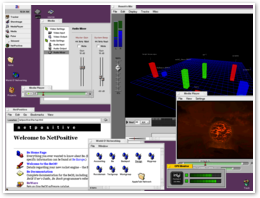 Unlike NeXT, Be sought to build an entirely new platform rather than leveraging existing OS technologies. The BeOS saw little actual use in business environments, so little of the system was ever battle tested, and many common features of modern operating systems were never implemented. One notable example of this was its lack of any type of multiuser environment or any provision for file permissions.
Unlike NeXT, Be sought to build an entirely new platform rather than leveraging existing OS technologies. The BeOS saw little actual use in business environments, so little of the system was ever battle tested, and many common features of modern operating systems were never implemented. One notable example of this was its lack of any type of multiuser environment or any provision for file permissions.Be's struggle to survive helped to demonstrate that the era of new, speculative operating systems was over. It was simply far too much work to reinvent an operating system from scratch.
Because the BeOS only offered limited compatibility with POSIX, and lacked the same rapid development tools of NeXT, the practical advantages of Be over the Mac were very limited.
After finding no luck with selling BeBox hardware, Be ported its BeOS to run on Apple's Mac hardware. Predictably, it faced the same barriers to entry as alternative operating systems had on the PC: why buy a new OS when a "free" one already exists and is installed? Why write custom software for a platform few people have installed? Be found the same set of troubles again after later porting the BeOS to run on standard PCs.
Putting the Mac on a PC
In the early 1990's, any glimmer of hope left for the introduction of new, unique hardware platforms was quickly waning. NeXT, Sun, and Be were all discovering the same reality: maintaining a custom hardware platform was very difficult.
They were all about to find out that attempting to compete in the commodity PC space against DOS and the newly emerging Windows was also going to be impossibly difficult.
Even Apple had explored the possibility, internally porting most of the Mac system software to the PC in a project with Intel called Star Trek.
However, deploying Star Trek would have killed the existing Mac hardware platform, which was Apple's entire revenue stream. It would also introduce an entirely new "PC Mac" platform. Would users suddenly shift to a new PC Mac, or would they simply migrate to Microsoft's emerging Windows platform?
The Software Problem
A key problem for Star Trek was that it would have demanded a complete rewrite of all available third party Mac software. As noted in Why Apple Hasn't Used Intel Processors Before, Apple had no capacity to deliver cross platform development tools; too much of the Mac's third party software was dependent on code that talked directly to the underlying hardware.
Previous lessons learned about the difficulty of introducing brand new platforms lead the company to shelve the idea. For some of the same reasons, Apple also ended development of the RISC Jaguar concept and instead worked to maintain and improve upon its existing Mac software platform.
Rather than replace the Mac, Apple now planned to first move it to run on a more modern hardware platform, and then later retrofit its core operating system features.
However, Apple, NeXT, and Be were running out of time. While each experimented with various survival strategies, they were all increasingly minor players in an industry that was beginning to standardize on a new desktop platform: Microsoft's Windows 3.0.
After a long gestation, Microsoft was finally seeing brisk sales of their graphic shell for DOS, partly due to the arrival of Adobe PageMaker for Windows. Suddenly Windows had the same killer app that had originally driven sales of the Mac.
Instead of competing strongly against Microsoft, Apple actually made a series of grave errors that paved a clear path for Windows. The next segment explains how.
This Series

| | Comment Preview
 Read more about:
Read more about:

 Send |
Send |

 Subscribe |
Subscribe |
 Del.icio.us |
Del.icio.us |
 Digg |
Digg |
 Furl |
Furl |
 Reddit |
Reddit |
 Technorati
Technorati
Click one of the links above to display related articles on this page.
1990-1995: NeXT, Be, and the Mac PC
Friday, September 8, 2006






Ad




